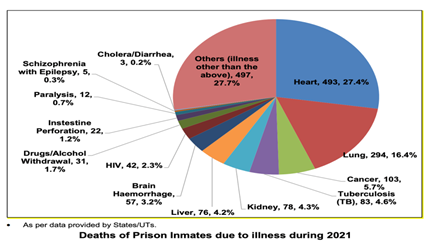

26th September 2023 (8 Topics)
Context
Recently, the Supreme Court Committee on Prison Reforms found suicide to be the leading cause of ‘unnatural’ deaths — deaths other than ageing or illnesses — among Indian prisoners.
Highlights of the report:
- Uttar Pradesh recording the highest number of suicides between 2017 and 2021.
- The number of custodial deaths has seen a steady rise since 2019, and 2021 has recorded the highest number of deaths so far.
How are prison deaths classified?

- Prison deaths are labelled as ‘natural’ or ‘unnatural’ by the Prison Statistics India report published by the National Crime Records Bureau every year.
- In 2021, a total of 2,116 prisoners died in judicial custody, with almost 90% of cases recorded as natural deaths.
- Natural’ deaths account for ageing and illness. Illness has been further sub-categorized into diseases such as heart conditions, HIV, tuberculosis, and cancer, among others. As the prison population swells, recorded natural deaths have increased from 1,424 in 2016 to 1,879 in 2021.
- ‘Unnatural’ deaths are more diverse in classification, profiled as:
- Suicide (due to hanging, poisoning, self-inflicted injury, drug overdose, electrocution, etc.)
- Death due to inmates
- Death due to assault by outside elements
- Death due to firing
- Death due to negligence or excesses
- Accidental deaths (natural calamities like earthquakes, snakebites, drowning, accidental fall, burn injury, drug/alcohol consumption, etc.

Factors responsible for deaths:
- The infrastructural deficiencies are both a cause and effect of callousness and neglect of the health of individuals in jail custody.
- The neglect could be medical, psychological or a continued denial of access to healthcare, food or safety.
|
Almost 1.5% of the prison population suffers from mental illnesses, per the CHRI report. |
What are the Provisions Available Regarding Custody?
- Constitutional Provisions:
- Article 21: Article 21 states that “No person shall be deprived of his life or personal liberty except according to procedure established by law”.
- Protection from torture is a fundamental right enshrined under Article 21 (Right to Life) of the Indian constitution.
- Article 22: Article 22 provides “Protection against arrest and detention in certain cases”.
- The right to counsel is also a fundamental right under Article 22(1) of the India constitution.
- Role of State Government:
-
- Police and public order are State subjects as per the Seventh Schedule of the Constitution of India.
- It is primarily the responsibility of the state government concerned to ensure the protection of human rights.
- Role of Central Government:
- The Central Government issues advisories from time to time and also has enacted the Protection of Human Rights Act (PHR), 1993.
- It stipulates establishment of the NHRC and State Human Rights Commissions to look into alleged human rights violations by public servants.
How are deaths investigated?
- For custodial Deaths: The NCRB is required to intimate a custodial death within 24 hours, followed by post-mortem reports, magisterial inquest reports or videography reports of the post-mortem.
- If an enquiry by the Commission into custodial death discloses negligence by a public servant, the Commission recommends to authorities of Central/State Governments for paying compensation to the Next of Kin (NoK) and also for initiation of disciplinary proceedings/prosecution against the erring public servant.
- In case of Custodial rape and death: The Code of Criminal Procedure also requires compulsory judicial magisterial inquiry in place of an executive magistrate inquiry.
- The National Human Rights Commission in 2010, however, weakened the legal requirement to say inquiry by a judicial magistrate is “not mandatory” when “there is no suspicion or foul play or where there is no evidence or allegation of an offence.”
Supreme Court’s Judgments:
- The Supreme Court in a 1996 judgment mentioned that, prisoners’ incarceration places limitations to access; no physician of choice, no second opinions, and few if any specialists.
- Secondly, because of the conditions of their incarceration, inmates are exposed to more health hazards than free citizens.”
Provisions for protection of prisoners:
- The Model Prison Manual of 2016 and the Mental Healthcare Act of 2017, outline inmates’ right to healthcare, which includes adequate investment in healthcare facilities, setting up mental health units, training officers to provide basic and emergency care, and formulating suicide prevention programmes to thwart such instances.
Suggestive measures:
- To prevent suicides specifically, guidelines recommend a strict check on tools such as ropes, glasses, wooden ladders, pipes.
- Initial mental health screening at the time of entry into jail is required and installing CCTV cameras to monitor high-risk inmates.
- Human rights activists have cautioned against the latter measure, as heightened surveillance would violate the rights of prisoners.
- It flagged a dearth of correctional staff including psychologists, “limited access to mental healthcare resources”, inadequate identification of mental illnesses in inmates along with heightened vulnerability and stigma.


